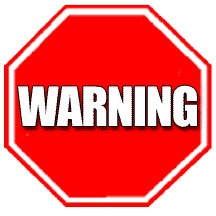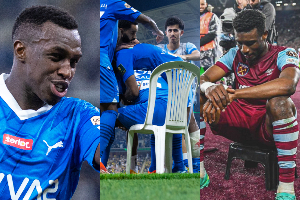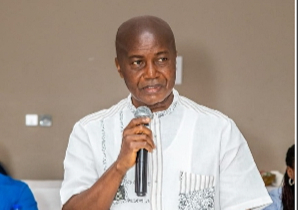Diasporia News of Tuesday, 25 February 2014
Source: Gonjaland Association UK & Ireland
Gonjaland Association UK & Ireland warn govt

Give us our Region or face protest-
"In a moment of decision, the best thing you can do is the right thing to do. The worst thing you can do is nothing." Theodore Roosevelt.
Gonjaland Association UK & Ireland is urging His Excellency President John Dramani Mahama to re-visit the creation of a new region out of the Northern Region as a matter of urgency. The Issue of the new region which got to Cabinet level during the era of Ex-President J. A. Kuffour seem to have been put on the back burner by the present regime.
The Association is fully aware that the President is presently inundated with large volumes of requests of all sorts but the issue of a Gonja region remains a matter of priority for the people of the Northern region and must be given the necessary attention. The Association takes the view that it is the right thing to do and must be done sooner rather than later as its members and the wider Gonjaland community are growing increasingly frustrated by the Governments lack of interest in the matter.
The creation of regions for administrative and development purposes dates back to pre-independence and is necessary to adapt to the changing conditions of the times.
It is said that history is a pattern of timeless moments and certainly no one analysing the creation or splitting of regions in Ghana can ignore their history.
As far back as 1900, the coastal region of Ghana formerly the Gold Coast had been colonised by the United Kingdom and in 1901, Ashanti, which was already a British protectorate, was annexed. The Northern Territories Protectorate comprising the present three northern regions followed in 1902. After World War I, (1914-1918) the Allies divided Germany's African possessions among themselves- this included Namibia and Togoland. The League of Nations mandated Togoland to Great Britain and France. They split it longitudinally. Britain received the smaller western strip, which became Trans Volta-Togoland territory. This territory was administered from the Gold Coast until 13 December 1956, when it formally merged with the Gold Coast. Our beloved country was granted independence on 06 March 1957 and took the name Ghana. The eastern strip given to France became today’s Togo.
After the country’s independence in 1957, the Ashanti Protectorate became the Ashanti region. The Gold Coast Colony with the capital in Accra was split into Eastern and Western regions. The Northern Protectorate and the Northern part of Trans-Volta Togoland trust territory became Northern Region and the remaining part of the Trans-Volta Togoland including Anlo and Tongu which were then part of the Gold Coast colony became the Volta Region.
On 04 April 1959, the vast Ashanti region was split into Ashanti and Brong-Ahafo regions. On 01 July 1960, the Northern region was also split into Northern and Upper regions.
Similarly, in July 1970, the Western region was split into Western and Central regions (or the Central region was created out of the Western region with Cape Coast as its capital) and in 1971, the two cities of Sekondi and Takoradi merged into Sekondi-Takoradi to become the capital of the Western region. Further, on 23 July 1982, the Accra capital district and the Ada local council split from the Eastern region to become the Greater Accra region (capital- Accra) and finally, in 1983 the Upper region was split into the Upper East and Upper West regions with their capitals as Bolgatanga and Wa respectively. So with only three regions in 1902 (Ashanti, Gold coast colony and Northern Territories Protectorate) the country has grown expansively into 10 regions to accommodate the growing population and to accelerate development through efficient administration.
The Northern Region though, remains the largest of all the ten regions in the country. With a land area of about 70,384 square kilometres or 27, 175 square miles the region is more than 21 times the size of Greater Accra Region. The second largest region is Brong-Ahafo with a land area of about 39’557 Square Kilometres or 15 273 square miles followed by the Ashanti region with about 24,389 square kilometres or 9’417 square miles. The rest are the Western Region; 19’323 square kilometres or 9244 square miles, eastern region 19, 323 square kilometres or 7461 Square miles, Upper West 18’842 square kilometres 7134 square miles, Central Region 9’826 square kilometres, Upper East 8’842 square kilometre 3’414 square miles. Greater Accra Region 3’2454 square kilometres 1’253 square miles.
The Northern region comprises of four major kingdoms namely the Gonja's, Dagombas, Mamprusis and the Nanumbas and several other tribes, including the Nawuri’s, Konkombas, Bimobas, Chokosis, Mo’s Lobi, Kamara, Vagla, Tampulma’s, Safalba and Hanga.
Gonjaland Association UK & Ireland takes the view that one of the reasons the Northern region is developing at such a snail’s rate is because of the vastness of its size. It is our conviction that the splitting of the Northern region or creation of another region out of the huge Northern region is long overdue and outrageously so. It is our suggestion that the new region should be named Gonja region with its capital situated at Buipe. The new region, if created will bring a lot of socio-economic development to the northern sector as evidenced in the progress and development the Brong-Ahafo and the Upper regions have experienced in recent times.
Opponents of the idea to split the region have often cited the population of the region as a reason to leave it as it is. However, we think this is a far-fetched excuse and an argument that is self-defeating if not illogical. As a result of the size of the region, there are very few opportunities for the younger generation and this has caused a large number of young men and women of the region to migrate to the Southern sector in search of jobs. They end up carrying undertaking jobs such as market porters (Kayayei) in Accra and Kumasi thereby increasing the population in these places and depleting the population in the North.
Not only has this tainted the reputation of the Northern people it is adversely affecting the development of the Northern territory. If split up, the new region will have the potential of creating new jobs and opportunities for the entire country. It will inject a new spirit of enthusiasm towards development in the north and help curb the migration of poor northerners to the southern sector.
Our request is strictly for development purposes and has nothing to do with the people of Gonjaland wanting to break away from our neighbours. We have always lived together in the north as a family and the split will not change that. Those who are familiar with the North will know that over the years there has been great deal of inter-tribal marriages and this has helped strengthened the relationship between various tribes. We believe that our cordial relationship will continue to flourish into the foreseeable future. Moreover, the request for a new region as mentioned earlier and as most readers already know is not new, nor is it being made because we have a Gonja as a President. The idea was put before Ex-President Jerry John Rawlings and Ex-President J. A. Kuffour. During Ex-President Kuffour’s regime deliberations reached Cabinet level but have since been shelved for reasons unknown. The Northern Regional House of Chiefs voted unanimously for splitting of the region and the idea is supported by a majority if not all of the northern people and their chiefs.
In fact a recent informal survey showed that a majority of the people of Northern Ghana and especially members of the Gonjaland Association UK & Ireland are becoming increasingly frustrated by the slow pace of Government to execute the split. It is for this reason that Gonjaland Association UK & Ireland is calling on His Excellency, President John Dramani Mahama to re-visit the idea once again and set it in motion without any further delay or excuses. Where ever the previous regime left off, we are respectfully urging the present government to please proceed and put in place a time-table for the creation of the region.
The split is a key element to our socio-economic development and we shall continue to put pressure on government until it happens. If constructive measures are not put in place for the creation of the region by the end of this year, the Association will resort to protest and other means to get the Government’s attention.
Gonjaland Association UK/Ireland
Awudu Sannie (awudu2000@hotmail.com)
Solomon Tampuri (sal_solomon@hotmail.com)
Sheriff Adams (adamsheriff2008@gmail.com)
gonjalanduk@hotmail.co.uk










